Today, the apple tree is the undisputed leader among other fruit trees growing in Russian gardens. These plants are grown both at equatorial latitudes and in rather frosty corners of our planet. Apple trees are unpretentious in care, adapt perfectly to the most various types soils and weather conditions.
However, to guarantee an excellent harvest in the garden, it is necessary to choose the types of this fruit tree that are most suitable for a given geographical location. Today, the best varieties of apple trees are very popular for middle zone Russia, characterized by both good yield and high taste of fruits.
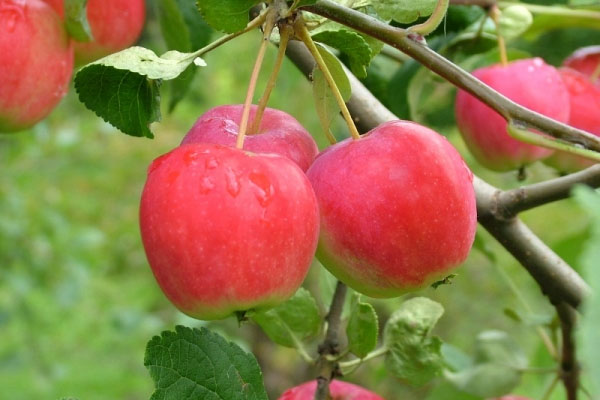 It should be noted that all varieties of apple trees grown in central Russia are divided into 3 types: autumn, summer and winter.
It should be noted that all varieties of apple trees grown in central Russia are divided into 3 types: autumn, summer and winter.
For example, the fruits of summer varieties ripen in the middle of the summer season, autumn varieties - at the beginning of autumn, and winter varieties - at the end of autumn.
 Raika apple variety
Raika apple variety
The described Rajka apple tree is the best winter variety of fruit plant, bred in the Czech Republic and characterized by a high immune system. It is characterized by a rounded beautiful crown with a compact growth force. The crown is formed easily since the shoots extend horizontally from the central trunk. The tree is extremely resistant to powdery mildew and scab.
The apple tree bears one-dimensional fruits, weighing about 150 grams, flat-round in shape with a light yellow color and a characteristic red blush over almost the entire area of the apple. The pulp is juicy, yellow in color with a pleasant and aromatic sweet and sour taste. In terms of taste, this variety is not inferior even to the “Champion” variety.
 Apple variety Pinova
Apple variety Pinova
The described Pinova apple tree is a popular German winter variety of fruit plant. It has a compact crown, high yield and very tasty apples. The species is characterized by excellent resistance to various ailments and is convenient when forming a crown. The tree bears fruit of medium volume, round-conical in shape.
The main color is yellow with a red side. The pulp of the fruit is viscous, as if rubber, but quite tasty. Harvesting can be done in the last ten days of September. When stored in the basement, they can remain until February without significant loss of their taste.
 This Zhigulevskoe apple tree is an autumn variety of trees, just like the Red Johnprince variety. True, depending on where it grows, it belongs to either an early autumn or late autumn species. This plant is the result of crossing the Wagner and Borovinka apple trees, which was produced at the Samara experimental station. The variety is high-yielding.
This Zhigulevskoe apple tree is an autumn variety of trees, just like the Red Johnprince variety. True, depending on where it grows, it belongs to either an early autumn or late autumn species. This plant is the result of crossing the Wagner and Borovinka apple trees, which was produced at the Samara experimental station. The variety is high-yielding.
The tree bears large fruits, weighing about 120-200 grams; there are even apples weighing 250 grams. The fruits are round in shape, sometimes broadly ribbed with a dark red color on 50-80% of the fruit area. The pulp is slightly juicy with a sweet and sour taste. The peel is oily, shiny and durable.
Apple variety Red Chief
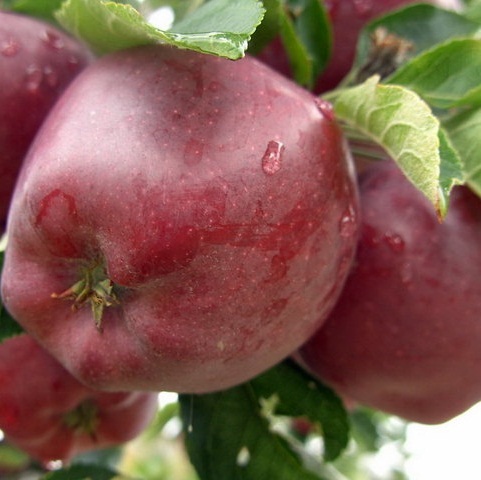 The described Red Chief apple tree is not a particularly popular variety, but the apples it produces are very tasty and also beautiful. The species was bred in the USA and is a kind of clone of the famous Red Delicious species. Apple trees are distinguished by early fruiting, the first harvests are produced already in 2-3 years of life.
The described Red Chief apple tree is not a particularly popular variety, but the apples it produces are very tasty and also beautiful. The species was bred in the USA and is a kind of clone of the famous Red Delicious species. Apple trees are distinguished by early fruiting, the first harvests are produced already in 2-3 years of life.
The plants bear fairly large fruits, the weight of which does not exceed about 200 grams. The fruits have a truncated-conical, slightly elongated shape. The apple pulp is dense, light cream in color, has a sweet taste and strong aroma.
Welsey apple variety
This Welsey apple tree was zoned in Russia in the 2nd half of the 19th century. In general, the plant is the result of the work of breeders from the USA, for the breeding of which the seeds of the cherry apple tree were used. Apple trees are low and medium in size. Initially, the crown is quite wide, pyramidal in shape, but with age it becomes slightly rounded.
The tree bears medium-sized fruits, the weight of the apple is about 80-150 grams. The apples are flattened and smooth, have a turnip-like shape. The main color is yellow, turning into golden over time. The peel is smooth, dense and thin with characteristic subcutaneous points. The pulp is juicy and dense, pale green or white. The Amber Necklace apple tree for central Russia has the same indicators.
Pobeda apple variety
 The described Pobeda apple tree was obtained by crossing the varieties Antonovka vulgaris with Pepin Londonsky. The result was a beautiful and powerful tree with a rounded crown. The plant is characterized by good winter hardiness, excellent immunity to various diseases, and abundant harvests.
The described Pobeda apple tree was obtained by crossing the varieties Antonovka vulgaris with Pepin Londonsky. The result was a beautiful and powerful tree with a rounded crown. The plant is characterized by good winter hardiness, excellent immunity to various diseases, and abundant harvests.
Full ripening of the fruit begins in the last ten days of September and ends in the first ten days of October. Most often, apples are large in size, weighing about 210-260 grams. The fruits have a flat-round shape with slightly visible ribs. The peel is smooth, strong and thin with a shiny sheen. Large subcutaneous dots are clearly visible on it.
Fuji apple variety
 This Fuji apple tree is a rather exotic plant, since it is the result of the work of Japanese gardeners in crossing two species - Red Delicious and Rolls Janet. Every year, the fruits of the Fuji variety gain more and more fans due to the large size of the apples, as well as their strong sweetness and freshness.
This Fuji apple tree is a rather exotic plant, since it is the result of the work of Japanese gardeners in crossing two species - Red Delicious and Rolls Janet. Every year, the fruits of the Fuji variety gain more and more fans due to the large size of the apples, as well as their strong sweetness and freshness.
The tree bears fairly large fruits, weighing about 200-250 grams, having a rounded-oblong shape, as well as dry, clean and smooth skin with a beautiful blush. The main color of apples is yellow-green with a striped blush that turns into pink or purple-red. The fruit pulp is tender with a creamy tint and a sweet-sour aftertaste.
Celeste apple variety
In general, the Celeste apple tree is a late-summer variety and was obtained in Germany, and the French species Delbarestivale was taken as the basis.
 The plant is medium in size, having a wide pyramidal, not very dense crown. Blooms relatively early. The tree bears large fruits, weighing about 200 grams.
The plant is medium in size, having a wide pyramidal, not very dense crown. Blooms relatively early. The tree bears large fruits, weighing about 200 grams.
The shape of the apples is slightly elongated or oval. The main color is yellow, while the outer color is represented by rich red-orange stripes. The fruit pulp is quite juicy with a yellowish tint. The fruit is characterized by a sweet and sour taste and a thin peel with a slight waxy coating. The Carolina Flower apple tree for central Russia has a similar description.
Apple variety Yablochny Spas
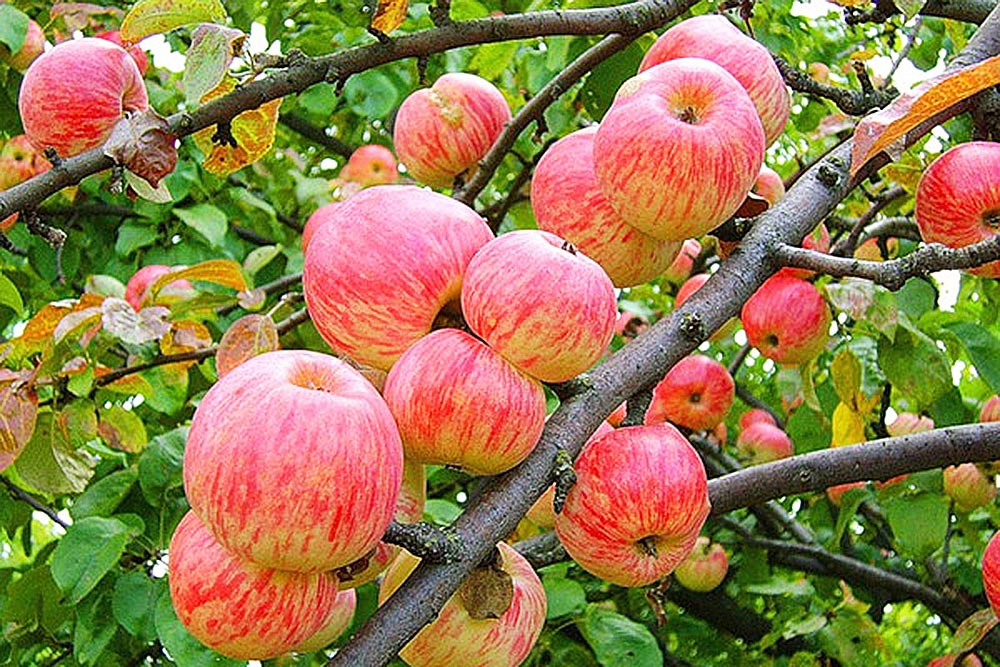 The described apple tree, Apple Spas, is a summer, triploid plant variety that has good immunity to scab. The tree was obtained as a result of crossing the species Papirovka tetraploid and Redfree. The tree turned out to be large, fast-growing with a rounded crown and medium density.
The described apple tree, Apple Spas, is a summer, triploid plant variety that has good immunity to scab. The tree was obtained as a result of crossing the species Papirovka tetraploid and Redfree. The tree turned out to be large, fast-growing with a rounded crown and medium density.
Florina apple variety
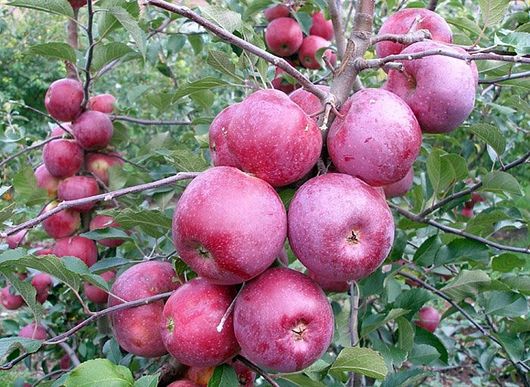 The Florina plant is a winter variety of apple. The tree was obtained by breeders from France by crossing the species Golden Delicious, Rum Beauty, Starking and the seedling Malusfloribunda 821. The apple tree turned out to be medium-sized, growing up to three meters in height with a widely rounded crown of strong density and strong skeletal branches.
The Florina plant is a winter variety of apple. The tree was obtained by breeders from France by crossing the species Golden Delicious, Rum Beauty, Starking and the seedling Malusfloribunda 821. The apple tree turned out to be medium-sized, growing up to three meters in height with a widely rounded crown of strong density and strong skeletal branches.
The apple tree bears large or medium-sized fruits, cut into a cylindrical shape with characteristic slightly smoothed ribs. The average weight of apples varies between 110-150 grams. The main color of the fruit is light yellow, while the outer color is located almost over the entire area of the fruit and has a thick or blurry striped tint. The peel is elastic and dense, dry and medium in size. Thanks to such indicators, the Florina apple tree has mostly positive reviews.
Apple variety Honey Crisp
 The described Honey Crisp apple tree is a product of American selection and was obtained as a result of crossing the Macoun and Honeygold species. For the first 3 years of its life on the site, the plant is distinguished by a narrow oval crown, while it grows very quickly and becomes medium-sized, and the crown acquires compact dimensions of a wide oval shape. Refers to the mixed type of fruiting.
The described Honey Crisp apple tree is a product of American selection and was obtained as a result of crossing the Macoun and Honeygold species. For the first 3 years of its life on the site, the plant is distinguished by a narrow oval crown, while it grows very quickly and becomes medium-sized, and the crown acquires compact dimensions of a wide oval shape. Refers to the mixed type of fruiting.
The apples are large in size, weighing about 180-250 grams, elongated-round or round-conical in shape, one-dimensional with a yellowish-light color with a blurry blush. The peel is quite dense, of medium thickness, smooth with a slight sheen. The pulp is dense, juicy and crispy yellowish-cream in color.
Apple variety Red Free
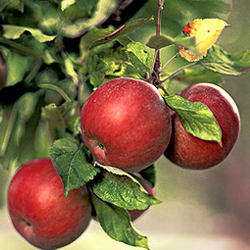 The described Red Free apple tree is a summer plant species of American selection, characterized by high resistance to scab. The tree is low-growing, growing up to 3-3.5 m in height, fast-growing. The crown of the apple tree is irregularly rounded, sparse and spreading. It begins to bear fruit 3-4 years after planting.
The described Red Free apple tree is a summer plant species of American selection, characterized by high resistance to scab. The tree is low-growing, growing up to 3-3.5 m in height, fast-growing. The crown of the apple tree is irregularly rounded, sparse and spreading. It begins to bear fruit 3-4 years after planting.
The tree bears fruits of medium volume, weighing about 140-150 grams, regular round shape, smooth and even. The peel is dense, smooth, medium thick and shiny. The main color is greenish-yellow with a typical blurry striped blush. The pulp is tender, medium-density, creamy-white in color.
Apple variety Era
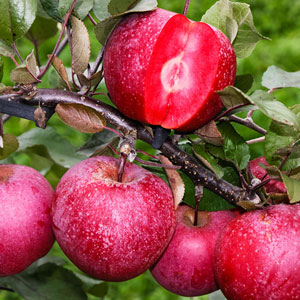 It should be noted that the Era apple tree is a completely new variety of apples bred in Switzerland. The plant is highly frost-resistant and immune to scab. The bark of the tree is cherry-colored, and the leaves have a red tint. The fruits are perfectly stored in a standard refrigerator or freezer.
It should be noted that the Era apple tree is a completely new variety of apples bred in Switzerland. The plant is highly frost-resistant and immune to scab. The bark of the tree is cherry-colored, and the leaves have a red tint. The fruits are perfectly stored in a standard refrigerator or freezer.
The apple tree produces medium-sized spherical apples, which are characterized by high antioxidant content (30-40% more than regular apples). Full ripening of the fruit begins at the end of September. The main color is dark crimson with a characteristic line in the center of white. Fruit weight is 150-200 grams with very tasty and juicy pulp.
Apple variety Miracle Garden
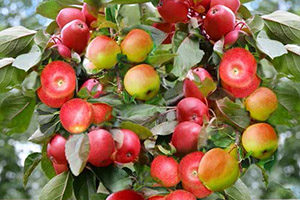 The described apple tree Miracle Garden belongs to late varieties fruit-bearing plants. It should be noted that the tree looks unusual and beautiful thanks to the fruits of different sizes and colors (green or red). The apple tree is different late apple ripening. This species is the most delicious variety of columnar trees, including the President variety.
The described apple tree Miracle Garden belongs to late varieties fruit-bearing plants. It should be noted that the tree looks unusual and beautiful thanks to the fruits of different sizes and colors (green or red). The apple tree is different late apple ripening. This species is the most delicious variety of columnar trees, including the President variety.
The significant taste characteristics of the fruit are complemented by the pleasant aroma of their pulp. So compact and ornamental plant will be a good decoration for a small garden. The height of apple trees reaches 2.5 meters. Moreover, the tree perfectly tolerates frosts of about -30 degrees Celsius.
Enterprise apple variety
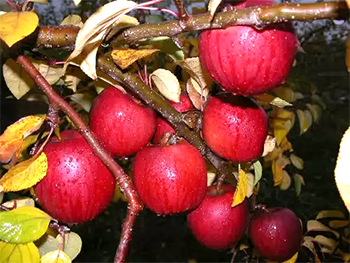 The described Enterprise apple tree is an autumn-winter species of fruit plants bred by American breeders. Fruit ripening begins at the very beginning of September. The plant is medium-sized, producing fairly large apples, weighing about 170-210 grams. The fruits have a round shape and never fall off.
The described Enterprise apple tree is an autumn-winter species of fruit plants bred by American breeders. Fruit ripening begins at the very beginning of September. The plant is medium-sized, producing fairly large apples, weighing about 170-210 grams. The fruits have a round shape and never fall off.
The main color of the fruit at the time of harvest is yellow-green with a characteristic solid, diffuse dark red blush. The pulp is juicy, fine-grained, yellow-cream in color with an aromatic sweet and sour taste.
The plant has good immunity to scab and average resistance to powdery mildew.
The description of the Honey Crisp apple tree for central Russia is similar.
Apple orchard
 In conclusion, it should be noted that today the tireless work of breeders from all over the world allows residents of almost every climatic region, even the most severe, to acquire their own apple orchard. Regular crossing of species makes it possible to obtain species that are very resistant to both severe frosts and hot temperatures, and to a wide variety of diseases.
In conclusion, it should be noted that today the tireless work of breeders from all over the world allows residents of almost every climatic region, even the most severe, to acquire their own apple orchard. Regular crossing of species makes it possible to obtain species that are very resistant to both severe frosts and hot temperatures, and to a wide variety of diseases.
About 400 varieties of apple trees are included in the State Register. And if we add local ones, new or outdated, but still living in our gardens, the list will be impressive. What varieties are the most common?
Each region has its favorites. We have compiled a kind of top 5 most popular varieties for central Russia of different ripening periods. We also offer an alternative - less common, but noteworthy varieties.
Number 1.Pouring white- an old local early summer variety, the very first apple of the season, ripens from the beginning of July.
The dessert tender, loose, sweet-sour pulp is to the taste of many, the fruits weigh 80-110 g. The variety is distinguished by high winter hardiness. Fruiting is sharply periodic. Years with a bountiful harvest usually bring problems - apples are stored for no more than two weeks, their transportability is poor. Scab affects trees, especially in wet years.
Number 2.Melba- a Canadian variety unsurpassed in popularity.

It belongs more likely to late summer or even early autumn; the fruits ripen in mid-September. It has earned popular love for its sweet and sour taste; its snow-white, juicy flesh has a strong, pleasant aroma. The fruits are medium (weight - 80-120 g). Apples are stored for 1-2 months. The tree is winter-hardy, productive, with high self-fertility. The disadvantages of the variety include the frequency of fruiting and susceptibility to scab. The fruits do not ripen at the same time and quickly fall off.
Summer varieties - an alternative
Arkadik- early summer domestic variety (VSTISP, Moscow), capable of competing with southern summer varieties. The pulp is juicy, sweet with barely noticeable sourness and has a strong aroma.
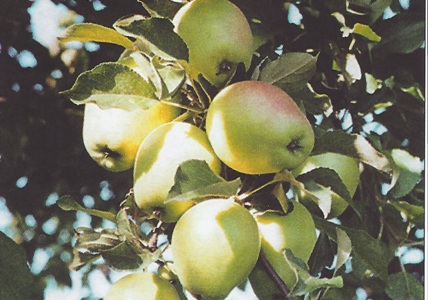
The fruits are medium and large (weight - from 80 to 180 g). The tree is vigorous, fast growing, and winter-hardy. Grows reliably in the Moscow region and northern regions of central Russia. The variety is resistant to scab.
Mantet- late summer variety of Canadian origin.
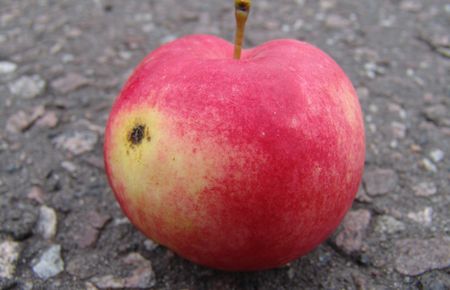
Creamy (pink under the skin) tender juicy pulp with a sweet and sour taste and strong aroma. The fruits are medium in size (about 130 g), do not ripen simultaneously, and their consumption period is about a month. The apple tree is winter-hardy, productive, early-fruiting, and resistant to scab. Disadvantages include vulnerability powdery mildew, poor transportability of fruits (stored after picking for no more than 15 days) and frequency of fruiting.
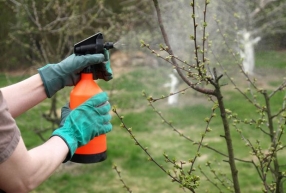
In memory of Tikhomirov- late-summer productive variety (M.V. Lomonosov Moscow State University), ripens in the second half of August.
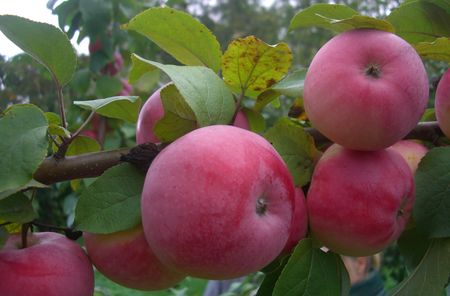
The fruits are large (weight - 100-150 g) and sweet and sour. The pulp is juicy, creamy, medium density, prickly, fine-grained. The apple tree is medium-sized and begins to bear fruit in the 6th year. The variety is self-fertile, resistant to scab, and winter-hardy.
Number 3. Autumn striped, also known as Streifling, or even Striefel, is a popular autumn Baltic variety of folk selection.
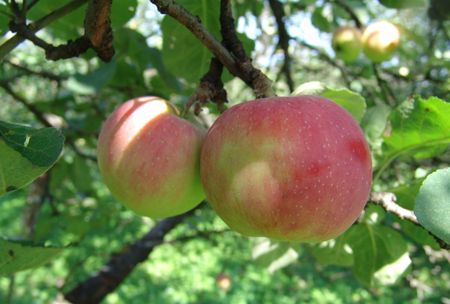
The dense, tender, juicy, slightly yellowish flesh of these apples has a pleasant, light wine flavor. The fruits are above average in size (weight - 120 g), ripen at the end of August, have good transportability, and can be stored until mid-November. The plant is winter-hardy, productive, and resistant to scab. Gardeners should take into account that the tree of this variety is vigorous and begins to bear fruit in the 7-9th year.
Autumn varieties - an alternative
Zhigulevskoe- late autumn variety created at the Kuibyshev Experimental Horticulture Station.
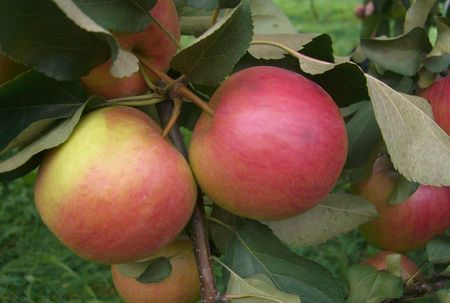
Apples ripen in mid-September and can be stored until February. Large fruits (weight - 150-200 g) with creamy, dense, juicy, sweet and sour pulp with a pleasant aroma. The tree is winter-hardy, medium-sized, productive. The variety is self-sterile (the best pollinators are Antonovka vulgaris, Cinnamon novoe), weakly resistant to scab, and prone to periodic fruiting.
Oryol striped- autumn variety (All-Russian Research Institute for Selection of Fruit Crops, Orel), ripening in early September.
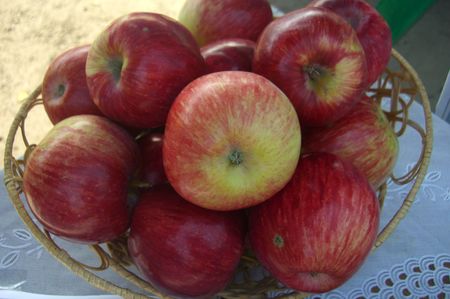
The fruits are stored until the beginning of December. The pulp is white with a creamy tint, fine-grained, tender, very juicy and aromatic. The taste is sweet and sour. The fruits are large or above average size (weight - 130 g). The trees are productive, early fruiting, with regular fruiting. The variety is relatively resistant to scab, winter hardiness is average (for the conditions of the Oryol region - above average).
Number 4.Antonovka vulgare- an old local Central Russian variety of late autumn or early winter consumption (in the State Register it is listed as early winter).
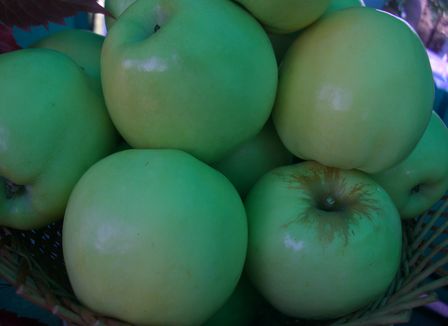
The fruits ripen in mid-September and are stored for up to 2-3 months. The pulp is juicy, coarse-grained, white, with some excess acid (and a high content of vitamin C) and a unique aroma. The fruits are large (weight - 125-170 g). The tree is winter-hardy, vigorous, productive. Disadvantages include sharply periodic fruiting, poor transportability of fruits, and susceptibility to scab and moth.
Number 5. Bogatyr- winter variety created in Michurinsk.

The fruits ripen in late September - early October, can be stored until May, and have good transportability. The pulp is dense, slightly juicy, crisp, white, with a sweet and sour taste and a pleasant aroma. The fruits are large (average weight - 175 g, maximum - up to 350 g). The tree is productive, tall, and has average winter hardiness and resistance to scab.
Winter varieties - an alternative
Orlik- winter variety (All-Russian Research Institute of Fruit Crop Breeding, Orel).
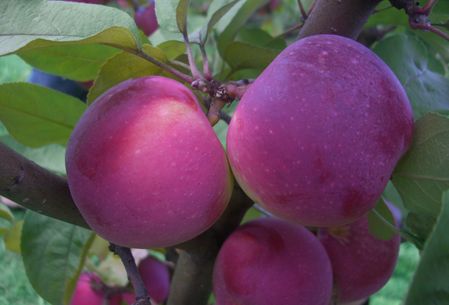
The fruits are harvested in the first half of September, at which point they are ready for consumption and can be stored until March. The dense, fine-grained, very juicy pulp has a strong aroma and a harmonious sweet and sour taste. The fruits are medium size (90-100 g). The trees are quite winter-hardy and medium-sized. The variety is early-bearing, productive, moderately resistant to scab, and is distinguished by the frequency of fruiting.
Sinap Orlovsky- late winter variety (All-Russian Research Institute of Fruit Crop Breeding, Orel).

The fruits are harvested at the end of September, but consumer ripeness begins in November and continues until the end of April. The pulp is greenish-cream, very juicy, prickly, different good taste, a harmonious combination of acid and sugar, weak aroma. The fruits are medium and large in size (weight - 120-150 g). The trees are quite winter-hardy, vigorous, fruiting is regular and moderate. The variety is relatively resistant to scab.
Subtleties of cleaning and storage
Growing an apple crop is not easy, but maintaining it can be more difficult. Fruits for long-term storage are collected in dry weather, only by hand and with great care. Shaking apples from trees is unacceptable; broken fruits are not stored. They are removed along with the stalk. You cannot remove apples by pulling them down, unscrewing or tugging. This leads to breaking off or tearing out the stalks and breaking the fruit branches.
Most apple varieties are best stored at temperatures close to zero and air humidity of 90-95%. At lower humidity, the fruits begin to wilt (the skin becomes wrinkled). Sharp temperature fluctuations with high air humidity lead to the appearance of moisture on the surface of the fruit, which leads to their massive rotting.
Enemy forces
Gardeners aren't the only ones who love to eat apples. One of the main enemies of the summer resident is codling moth. The main protective measures are cleaning, collecting and destroying dead bark in the fall or early spring, using catching belts, and constantly collecting and processing carrion throughout the summer. Amateur gardeners often use fermented Apple juice, which, in addition to the codling moth, also attracts moths, cutworms and other insects.

Apple flower beetle deprives many summer residents not only of the harvest, but even of the joy of admiring the spring flowering of trees. You need to start protecting the garden from the apple blossom beetle in early spring - trapping adhesive belts are applied to the trunk. Beetles are shaken off the branches during the period of swelling of the buds before the inflorescences extend. The procedure should be carried out early in the morning at air temperature
No higher than 8-10°C, then the beetles are inactive. This successfully replaces chemical treatments against apple blossom beetle.
The most harmful disease of the apple tree is considered scab, which reduces the yield and generally weakens the tree. When planting a garden, it is worth choosing modern, disease-resistant varieties. The main preventive measure is to remove the affected leaves after they fall from the garden; they can be burned, buried, composted. Treatment of the soil surface after leaf fall and tree crowns with concentrated solutions mineral fertilizers with a high nitrogen content (7% urea solution or 10% solution ammonium nitrate) significantly accelerates the mineralization of leaves, and the dormant stage of the pathogen does not have time to form. But in years favorable for the development of scab, and on varieties susceptible to the disease, it is impossible to cope with the disease without the use of fungicides.
The best 10 varieties of apple trees for the middle zone
The favorite fruit tree wherever the climate is suitable for its cultivation is the apple tree. Early, middle, late, sweet, sour, with a spreading crown and columnar, apple trees occupy first place among fruit crops.
Apples on tree branches
Apple trees need moderate watering and climate, without a lot of bright sunny days. They are easy to care for. In cultivated form, fruiting begins in the 4th – 10th year and yields are formed up to 40-50 years of age. Apples are loved in every family and are needed for a long period. How to select the best of the best, what features to pay attention to when choosing varieties?
How to choose an apple tree for your garden?
To select an apple tree for your garden that will suit all parameters, you need to study the varieties bred for the region/region and pay attention to the following characteristic features.
Winter hardiness of the variety
The ability to withstand the most severe frosts characteristic of the area, and to successfully withstand spring return frosts, autumn sudden drops in temperature and other weather disasters. The winter hardiness of the variety is not developed in apple trees. Resistance to cold is passed on from parents at the genetic level. Therefore, regardless of the region, you should always buy zoned varieties of apple trees for planting. They are bred for certain climatic conditions, are less susceptible to pests and are less susceptible to diseases.
Onset of fruiting and yield
For your home, it is better to buy early-fruiting varieties of apple trees that form the first harvest in the 2nd – 4th year. Medium-fruited ones form a harvest in the 5th – 8th year, and late-fruited ones – in the 9th – 10th – 12th year.
Productivity. It is advisable to select varieties of apple trees that bear fruit annually.
Apple ripening period
For your personal plot, it is necessary to select varieties with early, medium and late ripening so that summer varieties are replaced by autumn ones, and those by winter ones.
Summer apple tree varieties are harvested in late July and early August, depending on the region. By the time the fruits are harvested en masse, they reach biological ripeness, but they must be immediately used for food.
Mid-ripening apples are harvested at technical ripeness in September. When selecting varieties, you need to pay attention to the fact that some autumn varieties need to ripen after harvesting in order to acquire their characteristic taste and aroma.
Late apples are usually picked at the end of September - the first half of October. In addition to late and mid-late varieties, there are late-ripening varieties that are harvested at the end of October or before the onset of frost. Such varieties are immediately stored. Their fruits reach maximum ripeness gradually.
Autumn apple tree
Keeping quality of apples
From the varieties of apple trees of different ripening periods, according to the catalog of varieties, varieties with good keeping quality should be selected. Please note that summer varieties have a shelf life of 1-3 weeks, but some lose quality indicators after 6 days (they darken, rot, etc.). For autumn varieties, 30-60 days are considered good shelf life, and for winter varieties, at least 3-4 months. The best winter varieties of apples can be stored (if appropriate conditions are created), maintaining all their qualities, until the end of March - May and even until the next harvest.
Apple tree disease resistance
You should choose a variety of apple trees with high resistance to diseases, especially fungal (scab, rot and others) and pests. “Highly immune” varieties will require fewer treatments, which will reduce the cost of time and care in the future and will allow yields of environmentally healthy fruits.
Crown shape
For a personal garden with a small area, it is more practical to choose a variety of apple trees with a small or medium, compact crown habit. In this case, columnar varieties especially benefit, which form a crop on the central trunk and do not have a crown in the generally accepted sense. A spreading, loose crown will be good in a recreation corner, where it creates the necessary shade for vacationers, but in the garden it will occupy a large area and oppress other crops.
Taste is not the last thing
When choosing a variety of apple trees, be sure to pay attention to the quality indicators of the fruit: sweet, sour, juicy, with dense or loose pulp. Sweet varieties contain sugars of 10% or more.
For example: Start and Bolotovskoye 10.5%, Kandil Orlovsky 10.3%, and Rozhdestvenskoye 11.1%. The fruits of these varieties contain up to 0.4% free acid.
In the characteristics of varieties, pay attention to such an indicator as the sugar-acid ratio. With a value of 25% and above, the apples are sweet (acidity is not felt in the aftertaste). At lower levels (10-20%) the taste of the fruit is sour, like lemon. From 20 to 25% the taste is perceived as sweet and sour, sweet and sour with a different aftertaste.
We present to you ten the best varieties apple trees for the middle zone.
1. Northern synapse
The apple tree variety Northern Sinap is late-winter and has high frost resistance. The weight of the fruit does not exceed 90-150 g. The color of the skin of the apples is greenish-yellow with a red blush of pastel colors.
Apples of the “Northern Sinap” variety
The technical ripeness of the fruits of the Northern Sinap variety occurs in October, but the harvest is harvested after the leaves fall. When harvested earlier, apples lose taste qualities and keeping quality. Northern Sinap apples are juicy, sweet and sour with a spicy aftertaste and a refreshing aftertaste. The density of the pulp is medium, greenish in color, fine-grained. The sugar content in Northern Sinap is 11%, dry matter 15.8%, ascorbic acid 11.5 mg/100 product, P-active substances, including vitamin “P” – 102 mg/100 g, average acidity – 0.48%. The biological maturity of the fruits of the Northern Sinap apple variety occurs after 2-3 months of storage. An adult tree provides a yield of up to 150-170 kg.
Features of the Northern Sinap variety
Apple trees of the Northern Synap dwarf rootstock They form a harvest in the 2nd year, in a normal year - after 5-8 years. The crown on a regular rootstock is vigorous, wide, and of medium density. It has the ability, under certain conditions, to withstand autumn changes in night and day temperatures. The Northern Sinap variety is partially self-fertile. It can form ovaries without cross-pollination, but the yield is low. With high yields, the quality of the fruit decreases.
The value of the Northern Sinap variety
Early fruiting, average resistance to drought, fungal diseases, including scab, powdery mildew. The Northern Sinap apple harvest, harvested at the optimal time, can be stored until the beginning of June. The advantage of the variety is its excellent taste. The Northern Sinap variety is zoned for the Central Black Earth, Lower and Middle Volga regions, and the Moscow region. Can be grown in stale form in the East Siberian region.
2. Bogatyr
The Bogatyr apple tree variety is an old, time-tested variety (created in 1925) and today remains in demand in private gardening. Winter variety, high frost resistance. The variety is resistant to scab. Fruit weight 160-400 g.
Apple variety "Bogatyr"
The technical ripeness of apples of the Bogatyr variety occurs in September, but the harvest is carried out in October before the onset of frost. An adult apple tree can produce more than 100 kg of fruit of excellent quality.
When harvested, the fruits of the Bogatyr variety are yellow-green in color with very dense (almost like stone) pulp. Biological ripeness with characteristic taste properties occurs during ripening in storage - by the New Year. The skin of the fruit becomes yellow, sometimes with a bright red blush. The pulp becomes crispy, fine-grained, and medium-juicy.
At biological ripeness, the fruits of the Bogatyr variety are stored for more than 6 months.
The taste of the Bogatyr variety is sweet and sour, with an apple aroma. The average sugar-acid ratio is 20-25%. Sugar content 10%, dry matter more than 12%, vitamin C 13 mg/100 g of product.
Features of the Bogatyr apple tree variety
The Bogatyr variety is early-fruiting, fruiting occurs in the 4th year. The trees are tall, the crown is wide, spreading. Mostly 4-6 year old branches bear fruit.
The value of the Bogatyr variety
High organoleptic quality of the fruit (i.e., what is perceived by our senses). The Bogatyr variety bears fruit annually. Productivity is consistently high. Transportability is high, with preservation of marketability up to 90%. The state register recommends the Bogatyr variety for cultivation in the North-Western, Central and Central Black Earth regions. It also bears fruit in all regions with a suitable climate.
The Melba variety (often pronounced "Melba") originated in Canada. An old, time-tested variety (more than 100 years old). In Russia it grows everywhere where the climatic conditions are suitable.
Melba apples
Variety Melba with good winter hardiness in central Russia. Farther north may be subject to freezing and sunburn. Melba produces late summer crops, which are harvested from mid-August to mid-September. Due to the high taste qualities of the fruit, it is included in the group of the most popular varieties among the population. The Melba variety is early-fruiting. Fruit ripening is extended. The weight of the fruit depends on the growing region, 80-100, 100-150 g. Individual fruits reach 200 g. The pulp of Melba fruits is snow-white, fine-grained, juicy, crispy with a strong candy aroma (reminiscent of candy caramel). The taste of the fruits of the Melba variety is sweet and sour. The variety is distinguished by the elegant color of the skin of the fruit. The main color of the skin is light greenish with a transition to whitish-yellow when ripe. The cover is soft crimson with a striped blush. Melba fruits are covered with a light waxy coating, which contributes to good keeping quality. The fruits contain 10-11% sugars, organic acids 0.75-0.8%, pectin 9-10%, vitamin C 13-15 mg/100 g of product. The amount of P-active substances is 297 mg/100 g of product, which gives Melba fruits the ability to preserve vitamin C.
Features of the Melba variety
Melba trees are no higher than 2.5-3.0 m. On a dwarf rootstock - 1.6-2.0 m in height and in the first years resemble columnar ones. Over time, a wide crown of medium density is formed. Melba’s self-fertility is limited. It produces high yields with additional pollination. As trees age, they switch from annual to periodic fruiting. They may be affected by scab.
The value of the Melba variety
Fruitful. Long-lasting shelf life (in optimal conditions until November-December). Highly transportable. The Melba variety is zoned for all regions except the Ural, Northern and Far East. If Melba does not quite fit the description, please note that new varieties have been bred on the basis of Melba or with its participation and clones have been obtained that are superior in quality to the parent pairs .Clone Melba Red more resistant to scab. Forms charming fruits that are almost entirely raspberry in color and have a larger mass. Clone Melba's daughter Its performance is similar to that of the Melba Red clone. More frost-resistant.
The varieties Melba and Melba's Daughter, when planted together, are excellent pollinators. Of the varieties bred with the participation of Melba, they stand out for their quality indicators Zavetnoye, Early aloe, Red early, Caravel.
4. Bratchud
The Bratchud apple tree variety belongs to the group of dwarf forms of fruit crops (2.0-2.7 m). The variety is early-bearing (the first harvest is obtained in the 3rd – 4th year). High-yielding.
Apples of the "Bratchud" variety
With its miniature dimensions, an adult tree of the Bratchud variety produces a yield of up to 120 kg per tree. Refers to mid-winter varieties. Fruit harvesting at the end of September. The shelf life of the Bratchud variety is high, 4-5 months (January-February). Bratchud needs pollinators. The best varieties for pollination are Chudnoye, Podsnezhnik, Sokolovskoye, and Prizemlennoye. The Bratchud variety tolerates frosts down to -40°C. In hot summers, the variety reduces its taste and appearance fruits The average fruit weight of the Bratchud variety is 110-160 g, individual fruits reach 200-250 g. The fruits have a seam and noticeable ribbing. The color of the skin is greenish-yellow with a reddish-purple blush, pleasant. The skin is glossy. The pulp is white, coarse-grained, average juiciness. The taste of the Bratchud variety is sweet and sour. The fruits contain 14.1% dry matter, 10.2% sugars, 0.4% titratable acids, 1.5% pectin per 100 product. Vitamin C content 18.8 mg/100 g. Moderately resistant to scab.
Features of the Bratchud variety
The variety is winter-hardy. Pollinators are needed.
The value of the Bratchud variety
Natural dwarf. A variety used in breeding work.
Small dimensions, high yield and quality of fruit products.
High frost resistance and keeping quality of fruits.
5. Kovalenkovskoe
The Kovalenkovskoye apple tree variety is an excellent winter-hardy variety, bred in Belarus. Has excellent frost resistance.
Apples of the Kovalenkovskoe variety
Kovalenkovskoe is classified as a late summer or early autumn variety. Ripening covers the period from mid-August to the first ten days of September. Lovers of bright fruits call the Kovalenkovskoe variety a miracle of selection. At biological ripeness, the color of the fruit due to the continuous blush is bright red. The Kovalenkovskoe variety is early-fruiting. The harvest begins in the second year. The fruits are large, 150-200 g. But the ripening of the fruits is gradual, so harvesting is extended over time. The pulp of Kovalenkovskoye apples is moderately dense, juicy, fine-grained, with an apple aroma. It has a very sweet fruit taste. Sugar acid index from 25%. The fruits contain 13.6% dry matter, 11% sugars, 0.2% free titratable acids. 100 g of product contains 12.2 mg of ascorbic acid, 107 mg of P-active substances. The shelf life of apple tree fruits of the Kovalenkovskoe variety is 1.5-2.0 months.
Features of the Kovalenkovskoye variety
The tree is medium-sized, the crown does not occupy a large area when grown.
The productivity of the Kovalenkovskoe variety is stable and annual. The fruits do not fall from the trees.
The value of the Kovalenkovskoe variety
The Kovalenkovskoye variety is zoned for the central regions. High frost resistance allows Kovalenkovskoe to be successfully grown in the middle zone, regions of Siberia and the Far East.
6. Apple Saved
The Apple Spas variety is a summer crop variety that easily adapts to different climatic conditions. One of the best early varieties for summer cottages and garden plots.
Apples of the “Apple Spas” variety
The Apple Spas variety is early-fruiting and forms a harvest for the 3rd year. Consistently productive. Harvest ripening in mid-August, less often in early September. The variety is frost-resistant. It is highly resistant to a range of diseases, including scab. Even in years with epiphytotic scab infestation of apple trees, the Yablochny Spas variety practically does not get sick. The fruits of the Yablochny Spas variety are large, juicy, crispy with an apple aroma. The weight of the fruit is not less than 200 g. The main color of the fruit of the Yablochny Spas variety is yellow with a light pastel shade of green. The fruits are distinguished by their bright outer color, in the form of vertical stripes from red to crimson shades, which gives the apples an elegant appearance. The density of the fruit pulp of the Yablochny Spas variety is average, its structure and density do not change over time. The color of the flesh is light. The fruits contain 12.7% dry matter, 10.5% sugars, 15-17 mg/100 g of vitamin C product, 1% free acids, P-active substances 68.9 mg/100 g of product.
Features of the Apple Spas variety
The Apple Spas variety is considered self-fertile, but increases yields when several varieties are grown together.
The value of the Apple Spas variety
The variety is immune to scab and highly resistant to a whole range of diseases and pests. The Yablochny Spas variety is zoned for the Middle and Central regions of Russia, but successfully grows and bears fruit in other regions, including the Urals and Siberia.
7. Moscow necklace
The Moscow Necklace apple tree variety belongs to the columnar type of crop. Natural semi-dwarf, up to 1.8-2.5 m in height, has practically no branches. The main crop is located on the central trunk.
Apples of the Moscow Necklace variety
The Moscow Necklace variety is frost-resistant and disease-resistant. Withstands frosts down to -42°C. High-yielding. Precocious. In the first year of planting in a permanent place, it already forms a harvest of several fruits. With age, the yield increases to 10 kg per tree. The Moscow Necklace variety is late autumn, fruiting occurs in September-October. Apples are stored under optimal conditions for up to 7 months. By the time of biological ripeness, the apples of this variety change from green to dark red. The skin of the fruits of the Moscow Necklace variety is thin, dense, glossy with a slight waxy coating. Very elegant fruits with colored pulp. Large, weighing 130-250 g, juicy, sweet with a sour aftertaste.
In terms of taste, they belong to the dessert type. Dry matter content up to 25%, dietary fiber 1.8%, organic acids up to 0.8%, sugars 9.7%, sugar-acid ratio from 25%.
Features of the Moscow Necklace variety
The columnar apple tree Moscow Necklace bears fruit for about 15 years and must be replaced with a young seedling. The variety is self-sterile and needs a pollinator. The best of them are considered to be the Vasyugan and President varieties. During storage, the fruits of the Moscow Necklace variety are not affected by diseases and do not lose their taste.
The value of the Moscow Necklace variety
Natural semi-dwarf, easy to care for. Fruiting is annual. When covered in winter, it bears fruit even in harsh climates.
It is zoned for Central Russia, but can also be successfully grown in the Siberian regions.
8. President
The President apple tree variety is a columnar semi-dwarf. Height up to 2.0 m. The best late-summer domestic variety. The fruits ripen from the third ten days of August to the second ten days of September.
President variety apples
The President variety is early bearing. In the first year of planting in a permanent place, it forms a harvest of several apples.
The fruits of the President variety weigh from 150 to 250 g. The main color of the fruit is elegant yellow-white with a delicate blush of pink and purple shades. The skin of the fruits of the President variety is thin, but dense and shiny. The taste of the fruit is dessert, sweet and sour with an apple aroma. The pulp is fine-grained, white, medium density, very juicy.
The President variety bears fruit regularly for 10-15 years. With a decrease in yield, it must be replaced with a new seedling. When mature, it produces 10-16 kg of fruit per tree. The minimum shelf life of fruits is 1.5 months. If optimal conditions are created, fruits can be stored for 3-5 months without loss of quality.
In terms of chemical composition, the President variety is close to the Moscow Necklace variety.
The winter hardiness of the crop is high. If the top freezes during severe frosts, you can carry out spring sanitary pruning. The President variety recovers quickly after pruning. It has good resistance to pests and diseases.
Feature of the President variety
The President variety has strong and tough wood that does not break under the weight of the harvest.
Value of the President variety
Exceptional winter hardiness. Able to withstand frosts down to -38..-40°C.
Has good survival rate when transplanting seedlings. An excellent pollinator.
The President variety is zoned for the central zone of Russia. Can be cultivated in the chernozem and non-chernozem zones of the Russian Federation and CIS countries.
9. Bolotovskoye
The Bolotovskoye variety is relatively new (2002), but very promising for private gardening.
Apples of the Bolotovskoe variety
The Bolotovskoye variety is early winter, harvested in September. The tree is tall, the crown is sparse. Immune variety against some fungi, including scab. Frost-resistant (-30..-38°С). At -40°C, young shoots are damaged. The Bolotovskoye variety is medium-fruiting. The first harvests are formed in 5-6-8 years. Self-sterile. Pollinators are autumn varieties of apple trees. The Bolotovskoye variety produces annual harvests. The weight of the fruit is 100-150 g, but less often there may be 200 gram fruits. At biological ripeness, the fruits are yellowish or whitish-yellow with a diffuse blush without a waxy coating. The pulp of the fruit is dense, juicy with a greenish tint, crispy. The taste of the fruits of the Bolotovskoe variety is sweet with a pleasant aftertaste of sourness. In fruits - sugars 10.5%, titratable acids 0.31%, vitamin C 14.2 mg/100 g of product, pectin substances 17.1%, P-active substances 451-477 mg/100 g. Sugar-acid ratio at the level 25%.
The fruits of the Bolotovskoye variety have a high shelf life (until February). Storage at low temperatures improves the taste and does not reduce the quality of the fruit.
Features of the Bolotovskoye variety
If harvesting is not done in a timely manner, the fruits fall off the tree.
The value of the Bolotovskoye variety
Immunity to fruit and leaf scab.
10. Lungwort
The Medunitsa variety, despite the large size of the crown, is a favorite summer variety of summer residents.
Apples of the “Lungwort” variety
Variety Medunitsa forms early harvest amazing honey taste with good long-term shelf life for summer apples, which is 1.5-3.0 months. Under optimal conditions, the fruits are stored until the New Year holidays.
The Medunitsa variety is medium-fruiting and produces its first harvests in 4-6 years. The fruit weight is average and does not exceed 90-110 g. Apples have time to ripen on the tree in July-August. Ripening is not simultaneous, but the fruits do not fall off.
According to quality indicators, the Medunitsa variety is classified as a dessert dietary fruit. Sugar content - about 14%, vitamin C 7.8 mg/100 g of product, free acids 0.12%, pectin 10.1%, P-active substances 297 mg/100 g of product. The sugar-acid ratio is approaching 200 (sic!).
The external color of the fruits of the Lungwort variety is greenish-yellow with a blurred reddish blush consisting of red-brown stripes. The skin is smooth and dense. The pulp is yellowish, very juicy. The winter hardiness of the crop is above average, withstands frosts down to -25..-28°C.
Features of the Medunitsa variety
Weather conditions have virtually no effect on the formation of the crop and its quality.
During storage, the fruits of the Medunitsa variety acquire a more pronounced sweet-spicy taste and aroma.
The value of the Medunitsa variety
The Medunitsa variety is resistant to scab and fruit rot. The value of the variety is determined by the yield, optimal chemical composition fruits Recommended for central Russia, as well as areas with suitable climatic conditions.
This wonderful material was taken from the site http://www.botanichka.ru
Comments
about the author
PHARMACY IN THE GROUND Why go to the pharmacy for medicines when nature itself creates medicines for humans all around. Pharmacy gardens and beds have been known in Rus' since the time of Tsar Alexei Mikhailovich. Revive this useful ancient tradition along with a new series of varieties and hybrids of healing spicy and aromatic herbs - “Pharmacy in the Garden”. In your garden, right at your fingertips, they will grow and bloom, conveying to you their love of life and resilience - valerian officinalis, fragrant mint, aromatic cumin, creeping thyme, chamomile, purple coneflower, etc. And make a similar apothecary bed right in your garden extremely interesting. Most of the herbs collected in the series are very unpretentious and take up very little space, attracting a lot of beneficial insects and driving away pests. “Pharmacy in the garden” is great pleasure, positive emotions, plus enormous benefits for your health! High yield of fragrant greens! Vegetable anise Blues" Mid-season variety. The period from full germination to cutting for greens is 60-65 days, until the seeds ripen - 110 days. The plant is 30-50 cm high, weighs about 50 g. The rosette of leaves is vertical, the number of leaves is up to 20 pieces. Leaf long-petiolate, medium-sized, round-heart-shaped, medium-dissected, serrated edge, light green. Greens are used in cooking; seeds are added to canning. confectionery. Value of the variety: high foliage and uniformity, resistance to lodging and seed shedding. Borago (Borage) Gnome Greens with the aroma of fresh cucumber Annual herbaceous plant. The period from full germination to harvesting greens is 25-30 days. The plant is up to 30-60 cm high. The leaf is large, oval in shape, in adult plants it is hairy and pubescent. Blue flower. The weight of one plant is 200 g. Young cucumber grass is used as a salad plant. Its leaves have a strong fresh cucumber scent and a pleasant taste. Value of the variety: early ripeness and high yield. In medicine it is used as a diuretic, laxative, anti-inflammatory agent, for rheumatic pain and inflammation of the kidneys. Infusions of flowers and leaves are used as a soothing and refreshing remedy. Valerian officinalis Cardiola Useful medicinal properties Perennial herbaceous plant. The stem is hollow, up to 150 cm high. The root system is powerful and is located in the surface layer of soil. The flowers are white or pale pink, small, fragrant, collected in thyroid panicles. Blooms from June to August (in the second year). Value of the variety: high yield of medicinal raw materials. The rhizome with roots is used for medicinal purposes. IN folk medicine infusions, decoctions, and extracts are used as a sedative for diseases of the cardiovascular system, migraines, bronchial asthma, etc. St. John's wort Optimist" Early flowering already in the first year of sowing Perennial. The growing season is 110-130 days, from regrowth to full flowering - 80-85 days. The plants are semi-closed, 80-85 cm high. The stem is strong and green. The number of inflorescences on one plant is 6-8. Flowering duration is 41-51 days. Flowering plants in the first year of life - 100%. The flower is large, golden yellow in color with pronounced spots on the petals. In herbal medicine it is used as an analgesic, wound healing, diuretic, choleretic, anti-inflammatory and anti-ulcer agent. Vegetable snakehead Gorynych Description of the plant: Excellent honey plant. Mid-season variety. The period from full germination to the beginning of flowering is 60 days, until the seeds ripen 135 days. The plant is up to 70 cm high. The rosette of leaves is raised and closed. The leaf is medium sized, dark green, without anthocyanin. The number of shoots is up to 10 pieces. The inflorescence is loose, oblong, false whorl. The flower is large, pale purple. Weight of one plant is 240 g. Biological characteristics: It is undemanding to soil, but produces a high yield on fairly fertile chernozem, sandy loam and light loamy, moderately moist soils. Prefers fully illuminated areas; in shaded areas, the yield of green mass, seeds and content are reduced. essential oil; Resistance to environmental conditions and diseases: Resistant to adverse travel conditions and diseases. Agrotechnical features: Time for sowing seeds in open ground: at the end of May, sowing depth 2-3 cm, sowing pattern in rows with row spacing of 60-70 cm, 25-30 cm between plants in a row. Flowering duration: From mid-July to early September. Quality characteristics: Has a pleasant tart, fragrant, peppery aroma. Use: Leaves and flowers, fresh and dried, are used as a spice to flavor salads, first and second courses, tea, and when canning vegetables. In folk medicine, infusions and decoctions of the herb are used to stimulate appetite, for colds, neuralgia, gastritis, hepatitis, stomatitis, nephritis, etc. Hyssop officinalis "Accord" is drought-resistant, winters well, has a strong aroma. Perennial plant, leafy, up to 80 cm high. The stem is shortened, woody. The rosette of leaves is up to 25. The flower is pink, small. The weight of one plant is 840 g. The flowering shoots, fresh and dried, are used as a seasoning in cooking. respiratory tract, gastrointestinal tract, rheumatism. For medicinal purposes, flowers and upper herbaceous parts are harvested during flowering. A good honey plant. The variety is drought-resistant and winters well. Chervil Openwork Spicy seasoning for various dishes. Early ripening variety. The period from full germination to harvesting greens is 38-45 days, to flowering - 75 days. The rosette of leaves is raised, 25 cm high, 30 cm in diameter, compact. Medium sized leaf, light green. The flower is small, white. The aroma is good. In cooking, fresh leaves are used before flowering as a seasoning for meat and fish dishes, for preparing salads, for canning and pickling. In medicine it is used as a tonic and restorative. Catnip Basilio Delicate, persistent lemon aroma. Perennial. The period from full germination to the beginning of economic suitability is 62-65 days. The plant is erect, up to 120 cm high. The stem is tetrahedral, pubescent, highly branched. The leaf is petiolate, medium size, triangular-ovate, green with pubescence, the edge is coarsely serrated. The flowers are small, white, collected in paniculate-spike-shaped inflorescences. Weight of one plant is 95 g. It blooms in June-August. It has a lemon smell and a spicy-bitter taste. The above-ground part, harvested in June-August, is used for medicinal purposes. The infusion is used to improve appetite, for anemia, biliary and gastrointestinal colic, restless sleep, etc. Externally - in the form of a compress for boils and abscesses. Lavender Uslada An ideal combination of decorativeness and benefits. A perennial semi-shrub plant. The period from sowing to the beginning of flowering is 150 days. The plants are compact with numerous branched shoots up to 55 cm long, woody at the base. The foliage is average. The leaf is grayish-green, lanceolate. The flowers are blue-violet in color and collected in spike-shaped inflorescences, 5-8 cm long. The aroma is strong and specific. Fresh herbs are used as a seasoning. In folk medicine, flowers are used as a sedative and choleretic agent. Alcohol tinctures are used for rheumatic pain and neuralgia. Lovage Udalets" An unpretentious perennial plant with a strong persistent aroma. Perennial spicy-flavoring and medicinal plant . The period from regrowth to cutting is 25-30 days, to flowering - 85 days. The plant is compact, the hollow stem is up to 1 m high. The rosette of leaves is raised, up to 75 cm in diameter, the number of leaves reaches 40 pieces. The leaf is large, shiny, yellow-green, highly dissected. The flowers are small, yellowish, collected in an inflorescence - an umbrella. The aroma of the variety is high. Garden marjoram Baikal" Pleasant strong aroma and sharp spicy taste. A perennial subshrub, in the middle zone it is grown as an annual plant. The growing season is 170-180 days, from germination to harvesting for drying it takes 125-135 days. The plant is erect, 50-60 cm high The leaves are small, green, smooth. The flowers are small, white. The weight of one plant is 35 g. The leaves and young shoots with leaves and inflorescences are used in cooking and in canning vegetables. In folk medicine, decoctions and infusions are used. for diseases of the respiratory and digestive organs, as a wound-healing, tonic. Melissa officinalis Kadrill" High winter hardiness, heat resistance and disease resistance. A perennial plant up to 80 cm high. The period from full germination to cutting (in the second year of growing season) is 75-80 days. The rosette of leaves is raised, semi-closed, the number of shoots is up to 15. The leaf is medium-sized, dark green. The flower is small, light lilac. The weight of one plant is 250 g. The plants have a pleasant lemon smell and a bitter-spicy taste. Value of the variety: unpretentiousness, resistance to unfavorable conditions, high yield of green mass. Used in cooking to flavor tea, added when salting vegetables. In folk medicine, the infusion is used as a sedative for insomnia, neuralgia, asthma, anemia, as a diaphoretic and laxative. Plantain lanceolate Physician Plant description: Perennial herbaceous plant up to 50 cm high. The leaves are lanceolate, collected in a rosette of basal leaves. The flowers are small, collected in oblong-ovate spikes. Biological characteristics: Prefers fairly moist, fertile soils. Resistance to environmental conditions and diseases: Frost-resistant. Winters well. Agrotechnical features: When sowing seedlings in February-April, the seeds ripen in June. Flowering duration: Blooms in May-August. Quality characteristics: Sourish taste. The leaves contain the glycoside aucubin and 8% water containing up to 38% potassium and tannins; enzymes invertin and emulsin; saponins, organic acids, vitamins C and K, carotene, as well as lemon acid etc. Use: Young leaves are used for preparing salads, as an additive to cereals, purees and drinks. In folk medicine, decoctions and infusions of roots and leaves are used. The plant has blood purifying, anti-inflammatory, antitussive, diuretic, antispasmodic, expectorant and enveloping properties. Plantain is able to stop bleeding, accelerate epithelization and wound healing. Motherwort Samara cordial Huge benefits for your health. Perennial medicinal herb. Stems are 50-150 cm high. Leaves are dark green. The flowers are small, light pink, collected in false whorls in the axils of the upper leaves. Blooms in June-July. For medicinal purposes, leafy flowering tops 30-40 cm long are used. Infusion and decoction are used as a sedative, cordial, laxative, diaphoretic, wound healing agent, etc. Milk thistle Debut Description of the plant: Widely known as a medicinal plant. An annual prickly plant up to 1.5 m high. The leaves are leathery, with large white spots, the upper edges are jagged with yellow spines. The fruit is a black-yellow, shiny achene. Biological characteristics: Milk thistle is demanding that fields be kept free of weeds. It is unacceptable to sow it in fields littered with perennial root shoot weeds. Sandy loam soils with a loose and breathable soil layer are suitable for its cultivation; slightly acidic soils with a pH of 5.5-6.0 are preferred. The best predecessors of milk thistle are pure pairs or winter ones, going in pairs, perennial and annual herbs. Resistance to environmental conditions and diseases: The variety does not lodge or fall off. It is not affected by pests and diseases. Agrotechnical features: Sowing May 1-20, sowing pattern 70x70 cm, harvesting August 20-September 20. Duration of flowering: Seeds are collected in late August - early September, roots are dug in the fall. Flowering duration is 30 days. Uses: Roots, leaves and buds are consumed as a vegetable, using young leaves and petioles for salads. Seeds and roots are used for medicinal purposes. Tinctures and decoctions are used for diseases of the liver, gall bladder, articular rheumatism, chronic bronchitis, etc. Chamomile Aibolit is an unpretentious medicinal and ornamental plant. A most valuable medicinal plant, up to 40 cm high. Stems are straight, branched. Inflorescences are baskets sitting on long peduncles. Blooms from June to August. Grows everywhere in any soil. medicinal purposes use flower baskets. Inflorescences are harvested at the beginning of flowering (up to 6 times per summer). Pre-winter crops give the highest yield. Vegetable thyme Medok Perennial plant. The growing season from full germination to the last harvest is 150 days. A plant with creeping flowering shoots, up to 25 cm high. The foliage is high. The leaves are small, oblong-ovate, dark green above, grayish-purple below. The flowers are light pink, small, collected at the end of the branches in capitate inflorescences. The yield of green mass per plant is 50 g. It has a pleasant aroma and slightly bitter taste. The variety is light-loving, drought- and frost-resistant. In cooking, it is used as a seasoning, as a spice when canning vegetables, and added to tea. It is also used as a medicinal plant. Vegetable cumin Appetizing Mid-season variety. The period from the beginning of leaf regrowth to harvesting for greens in the second year of growing season is 35 days, until harvesting for seeds is 65 days. Biennial plant 60-80 cm high. The rosette of leaves is raised, semi-closed. The leaf is medium petiolate, medium size, yellow-green, without anthocyanin, medium dissection. The leaves have a spicy taste and weak aroma. The flowers are small and white. Fresh leaves are added to salads and meat dishes. The seeds are used as a spice and in folk medicine as a medicine. Yarrow Vasyurinsky Power of nature for your health. Perennial. The growing season is 120-128 days. The shoots are green. The plant is erect, 69 cm high in the first year of life, 116-139 cm in subsequent years. The stem is pubescent. The leaves are dark green, pubescent, corrugated. The flower is white. It blooms in June - September, the fruits ripen in July - October. Value of the variety: high winter hardiness and drought resistance. Has anti-inflammatory and bactericidal effects. Used in the form of infusions, decoctions, extracts for various diseases of the gastrointestinal tract, peptic ulcer and gastritis, the infusion acts as a hemostatic, used for headaches, night cramps in the legs, anemia, in the form of compresses for abscesses, festering wounds. Garden savory Picnic Strong spicy aroma and piquant taste. Early ripening variety. The period from full germination to the beginning of flowering is 55-58 days. The plant is 40-45 cm high, intermediate in shape, branched, well leafy. Weight of 1 plant is 70 g. The leaf is lanceolate, narrow, pointed, green. The flowers are small and white. The aroma of the variety is strong. Recommended for use in home cooking (salads, soups, meat, vegetable dishes), for flavoring vinegars and marinades, and for canning cucumbers. Vegetable sage Breeze "Irreplaceable benefits for the body. Perennial subshrub. The plant is erect, up to 60 cm tall, densely foliated. The leaves are elongated with a blunt apex, pubescent, finely toothed along the edges. The flowers are blue-violet, collected in loose spike-shaped inflorescences. High aromaticity. Blooms in June-July. The weight of one plant in the second year of vegetation is 250-280 g. It grows in one place for up to 5 years. Fresh and dry leaves are used as a seasoning in cooking, in the preparation of canned food, sausages, cheeses and wine. In folk medicine. bronchitis, colitis, gastritis, liver disease, kidney disease, etc. Vegetable sage Nectar Plant description: Perennial herbaceous plant up to 100 cm high. Leaves are oval-heart-shaped, pubescent, light green. Flowers are paniculate-branched. 40 cm long. Blooms in June-July. Excellent honey plant. Biological characteristics: The plant is light-loving, drought-resistant, prefers fertile soils. Resistance to environmental conditions and diseases: Drought-resistant. Agrotechnical characteristics: The best sowing time is before winter. At an air temperature of +10-12 °C, seedlings appear on days 12-14 (they easily tolerate frosts down to – 6-8 °C). Sowing May 1-15, sowing pattern 45 x 20 cm, harvesting June 20-August 30. Productivity: 0.5 kg/m2.Qualitative characteristics: Unique aroma. Use: Recommended for use in fresh and dried form (leaves and inflorescences), for flavoring various dishes, flavoring tea, cheeses. In folk medicine, the infusion is used for fever, to improve digestion, and for stomach ulcers. A decoction of the leaves as a gargle for acute respiratory diseases, laryngitis, and sore throat. Endive Spring Plant description: Early ripening. For growing in film greenhouses and open ground. The rosette of leaves is semi-erect, dense, 30 cm high, 30-40 cm in diameter. The leaves are light green, dissected, the core is elliptical, light yellowish-green. The weight of the commercial plant is up to 500g. Biological characteristics: The plant is cold-resistant, tolerates frosts down to -3 ° C. However, low temperatures during early sowing or planting seedlings in the ground can cause premature bolting. Endive is also sometimes damaged by autumn frosts. The plant is moisture-loving and demanding of soil fertility. It does not grow on acidic soils. Resistance to environmental conditions and diseases: Cold-resistant. Agrotechnical features: Sowing May 20-June 10, sowing pattern 20-30 x 20-30 cm, harvesting July 25-August 25. Productivity: 4 kg/m2. Quality characteristics: Plant with high vitamin C content. Use: Recommended for using leaves in fresh and in cooking. Tarragon Monarch" Irreplaceable benefits in every leaf. Perennial semi-shrub plant. The plant is erect, up to 150 cm high, highly branched and heavily leafy. The number of first order branches is up to 15 pieces. Young shoots are light green, up to 10-20 cm long. The leaf is sessile, large , up to 8 cm long, bright green, smooth, with dense short pubescence. Weight of 1 plant is 700 g. The smell is spicy, the taste is refreshing and pungent. Fresh greens are used as a salad and spicy seasoning in cooking, in canning and pickling, and in preparing tonic drinks. It is used in folk medicine as a strong antiscorbutic and diuretic, for vitamin deficiencies, to stimulate appetite and improve digestion.
The varieties of apple trees are very diverse. Each gardener chooses a variety based on personal preferences. However, first of all, it is important to determine the climatic conditions of the area where you plan to plant the apple orchard. These conditions may not be favorable for the plants you would like to grow.
But since the varietal assortment of apple trees is very large, it is possible to select varieties in such a way that the yield and taste of apples will be no worse than that of fruit crops, which are common in the southern regions of the country.
What to look for when choosing an apple tree variety
The main qualities for successful cultivation varieties are:
- drought resistance,
- frost resistance,
- resistance to diseases and pests.
And also, when selecting varieties according to ripening time, it is advisable to plant such apple trees so that they produce a harvest throughout the season, and the fruit is kept fresh for a long time cold winter when there are so few vitamins. That's what apple trees are for:
- summer,
- autumn and
- winter ripening periods.
Let's consider the best varieties of apple trees for the Moscow region and other regions of the Russian central zone.
Summer fruiting varieties
Begins to bear fruit in the 5th or 6th summer. The crown is round. The apples are medium-sized, weighing from 70 to 85 g. The fruit is conical, round, and has a straw-yellow color. Inside there is a delicate consistency, medium juiciness. Apples ripen in early August. In dry weather they fall off, and in wet weather they hang on the branches for quite a long time. The shelf life is short - they rot quickly. Overripe apples become tasteless and too crumbly. Plants do not always tolerate winter well; in very frosty weather they freeze. Has average performance in terms of resistance to scab.
It is considered one of the best varieties for the Moscow region, bred by folk breeders. Winter hardiness is excellent. The crown type is pyramidal. With proper care, it produces a very high yield. In the 5th or 6th season you can collect the first fruits. Small apples - 45–50 grams. They have a light green skin with a yellowish tint and a pinkish blush. Inside the fruit there is a fine-grained pulp structure that contains a lot of juice. Apples are sweetish and sour. They sing in the first weeks of August; they do not do this at the same time, so they are collected several times during the season. Trees live long and are valued by gardeners for this. The disadvantages of Grushovka are that it often gets scab, and the apples can fall off.
3. Pearl. The apple tree is not very tall. Tolerates winter cold well. It produces apples of yellow-golden color, with snow-white flesh. Although these are summer apples, the fruits can be stored for up to one month. This apple tree produces some of the largest fruit in size and weight among similar varieties. Sings in August.
4. Astrakhan white. A very old Russian variety. It is distinguished by excellent frost resistance and vigorous growth. The harvest can be expected 6-7 summers from the time the seedling is planted. It bears fruit evenly and annually. The apples are medium in size, good juiciness, and have a wine aroma.
American selection culture. Tree of medium vigor. Pyramidal shape of the crown structure. The variety is highly productive, but periodically there is a decline in fruiting. The apples are round, slightly flattened on top, yellowish-green, have a red blush, and have a sweet and sour taste. They have yellowish flesh and a very juicy structure. Apples are not meant to be stored for long periods of time. The shedding is very high. Fruits can be stored for two months, which distinguishes Mantet from similar varietal forms.
The tree is resistant to winter cold. The crown has a pyramidal shape. The harvest occurs in the 5th or 6th summer. Fruiting is even, there is rarely a crop failure. Average type of yield. Small apples 35-50 grams. The yellowish-green skin of the fruit is covered with a blush with red stripes. The apple is juicy, sweet and sour, greenish inside. Apples do not last long.
7. Bel Chernyshevskaya. The variety is very winter-hardy. The wide oval crown of the apple tree requires that trees be planted at a considerable distance from each other. The first harvest should be expected already in the 5-6th season. The fruits are round, slightly elongated. The variety has medium-sized apples, weighing 60–75 g. The fruits are light green in color and have a beautiful pinkish blush. Apples have increased juiciness and snow-white flesh. They taste sweet with a refreshing sourness. IN last weeks In July you can start harvesting fruits.
An excellent variety for growing in garden plots. Developed at the Michurin All-Union Research Institute on the basis of the Papirovka and Korobovka varieties. The trees are tall and fast growing. They begin to bear fruit in a period of 2 to 5 years, depending on the type of rootstock (on a weak-growing one earlier, on a vigorous-growing one later).
The fruits are medium in size, weighing 80-120 g, taste very sweet, with delicate pulp. The color of apples is yellow with a bright striped blush. Can be stored for up to two months.
The variety is characterized by unpretentiousness, high winter hardiness and good disease resistance.
Autumn varieties of apple trees
The high-yielding variety, however, “rests” in some seasons and fruiting decreases. Scab resistant. The crown structure is round. Fruits in the 6th or 7th summer. Apples weigh 120–150 grams. They are rounded and elongated, but can also be slightly flattened. The skin is thick, the apples themselves are yellow-green, and have a burgundy blush in the form of stripes. The fruits are harvested in the first days of September. After three to four weeks they can be eaten, and they are kept cool until the onset of winter.
9.Auxis. The crown of apple trees is small and oval. The size of the apples is average, and their weight is 100-170 g. They have a sweet and sour taste. The yellow-green color scheme of the apple has a blush of red colors. The color of the pulp is yellowish. Stores well until the last ten days of February. The peculiarity of the apple tree is that in order to pollinate it, trees of other varieties must grow nearby. The harvest should be expected already in the 4th or 5th summer. The variety is moderately resistant to winter cold. It rarely suffers from scab. Ripe apples fall off.
10. Zhigulevskoe. A long-bred and well-proven variety. Has good winter hardiness. The apple tree is not tall, its crown is wide, not dense, pyramidal. In the fifth year it bears fruit. Productivity is even, annual. The apples are round, of good juiciness, and have a characteristic red blush. Their weight is 130–200 grams. They keep well until January.
The tree is vigorous. It has a strong, widely spreading crown. It begins to bear fruit at the age of 5–7 years. The fruit weighs 100–130 grams, is straw-yellow in color, topped with a striped blush of red and orange flowers. Apples can be stored until December. The trees winter well and are highly resistant to scab. The fruits do not ripen at the same time, so they are collected several times during the season.
12. Young naturalist. The trees are medium-sized, their crowns are round in shape. Excellent winter-hardy qualities. The apple is round, flattened, about 100–120 grams. The variety is virtually not susceptible to scab. The skin is yellow-green in color, with a purple blush on top. The apple is sweet and sour with pulp of increased juiciness. They will sing in the last days of September. Apples can be stored for about two months.
13. Autumn joy. The tree has strong growth and winters well. The harvest is good and constant. Apples are higher average weight- 90–120 grams. Round or elongated-round shape. They are yellowish-green and have a red blush. Inside - good juiciness and light consistency, have a very pleasant smell. The apples are ripe in September.
Winter varieties of apple trees
Exceptionally winter-hardy. The first apples should be expected from the 5th to the 7th autumn. Fruits well. Scarlet anise is unpretentious to external conditions and soil composition. Suffers little from scab. The apple tree is a vigorous type; its crown has the shape of a circle. The apples weigh 50–65 grams, they are greenish-yellow, with a red-burgundy blush throughout the skin. They will sing in the last days of September. Stored in a cool place until December.
It is very winter-hardy and tolerates dry weather well. Bears fruit in the 5th or 6th autumn and is highly productive. To scab of average resistance. The apple tree is vigorous, the crown is pyramidal in shape. The harvest is ready for harvest in early October. Fruits weigh up to 80–90 g. The skin of the apples is greenish and has a blush with an orange-red tint. The pulp is not very juicy, white-greenish, with a sweet-sour taste and a wonderful smell. Until the beginning of spring, apples can be stored in a cellar or refrigerator.
16. Aport Alexander. The variety is moderately resistant to winter frosts and scab. The plant is a vigorous type, the crown is wide, very spreading, round in shape. It bears fruit in the sixth to seventh year. Demanding about tillage. The fruit is large, weighing half a kilogram, conical in shape, tapering towards its apex. The skin is yellowish in color, with a burgundy-red striped blush running along it; there may be specks. Apples have a strong aroma. Inside, they have a loose structure, sweet and sour taste, and have increased juiciness. Fruit harvesting takes place in October. They are stored in a cool place until the first days of March.
17. Peaceful. Tolerates the winter period well. The first fruits are obtained in the fifth to seventh autumn. Highly productive, but sometimes there are dormant periods. Almost never gets scab. The apple tree is vigorous, the crown is rounded, not very dense. Large-fruited variety- apples 150–170 grams. Under bad weather conditions or due to insufficient work to care for the plants, the fruits come in different sizes and even become smaller. Apples are round in shape, tapering towards the top. The apple is yellow-greenish, has a blush with a reddish tint. Inside is reddish pulp with a sweet-sour taste. Collection season is October. Store in a cool place until the first weeks of March.
